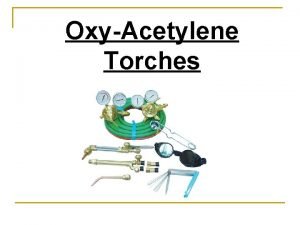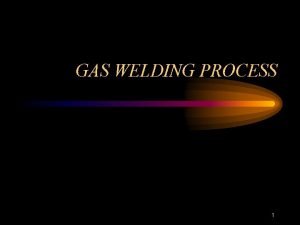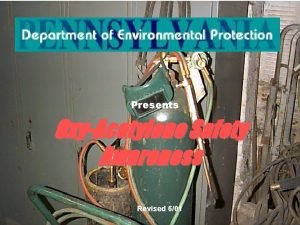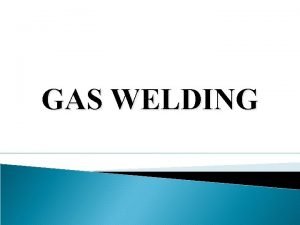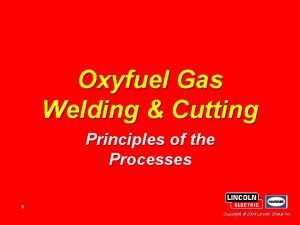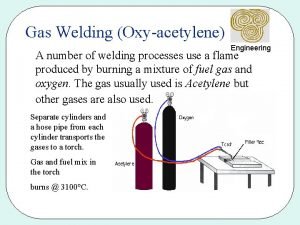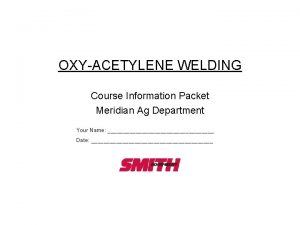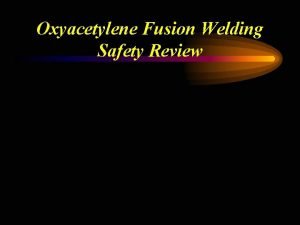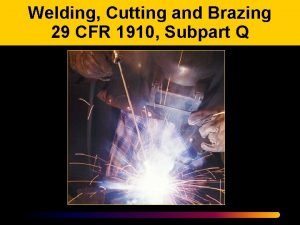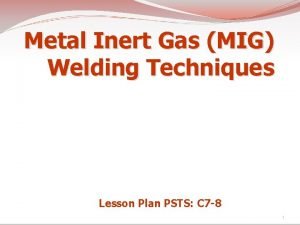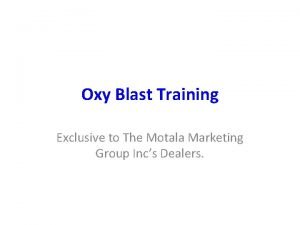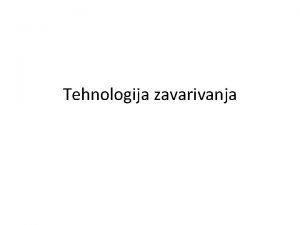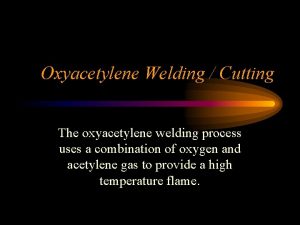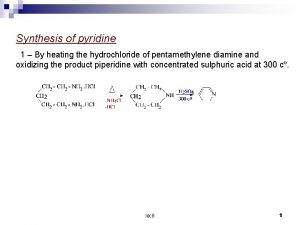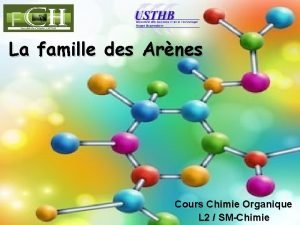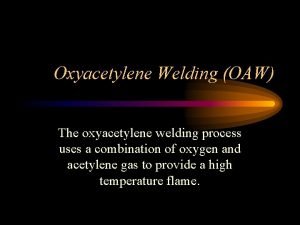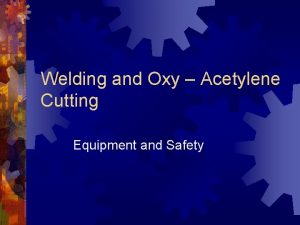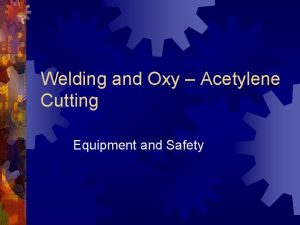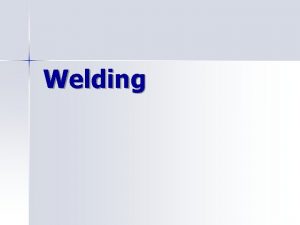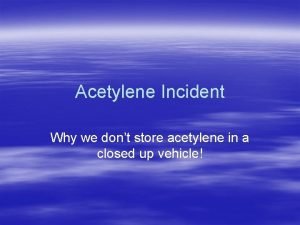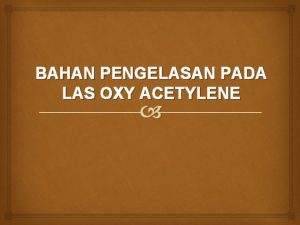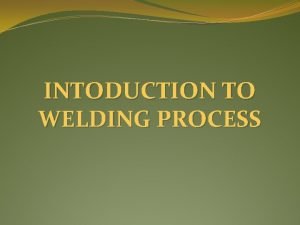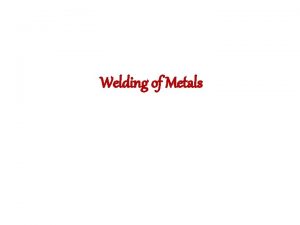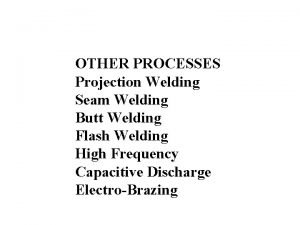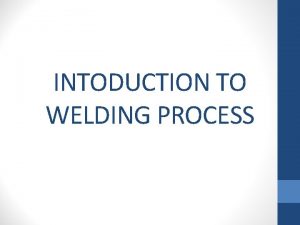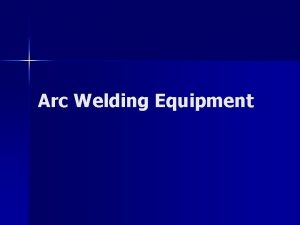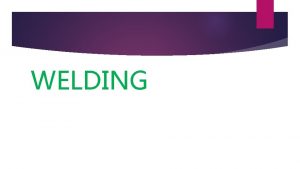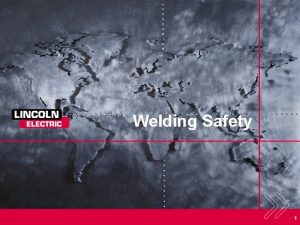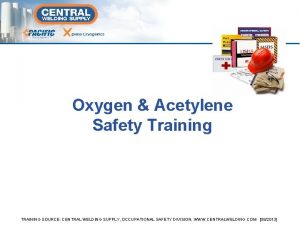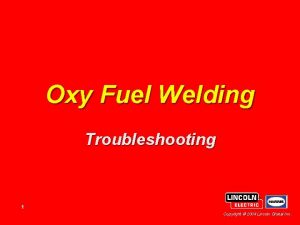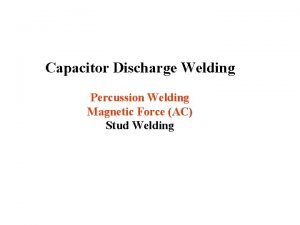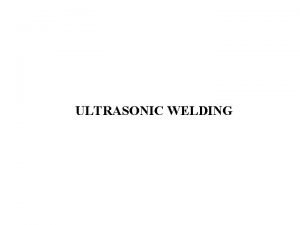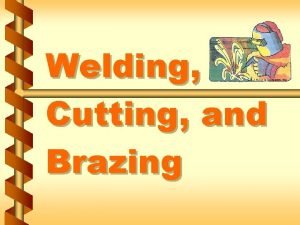Oxy Acetylene Welding 1 Oxy Acetylene Welding A




















- Slides: 20

Oxy Acetylene Welding 1

Oxy Acetylene Welding A form of Gas Welding n Often referred to as Gas Welding n Oxygen and Acetylene are the most common gases used. n 2

3

Oxy Acetylene Welding n n n It was the development of a practical torch in the early 1900’s that brought welding out of the blacksmith’s shop. The process is still popular today for small scale operations because of its portability, versatility (most ferrous and non-ferrous metals can be welded), as well as its low capital investment. The combustion of oxygen and acetylene by means of a welding torch produces a temperature of about 32500 C. 4

Storing the gases n Oxygen q Stored in a black gas cylinder q Right Handed Thread q Oxygen can be stored under high pressure n 173 bar 5

Oxygen Cylinder n n n Oxygen is not flammable, but will increase the combustion of flammable materials An oxygen rich environment will cause a ‘flash’ fire in which everything flammable will burn in seconds. Oxygen can ignite oil so workshop and clothes must be clean. 6

Storing the gases n Acetylene q q q Stored in a Maroon gas Cylinder Acetylene is unstable when under pressure It is therefore dissolved in a chemical called Acetone i. e. Dissolved Acetylene Room temperature & normal atmospheric pressure, Acetone dissolves ~25 times its own volume of acetylene. Increase pressure to 15 bar and it will dissolve 375 times its own volume. 7

Acetylene Cylinder n n n Filled with porous material Prevent the acetylene from exploding throughout the whole cylinder if local heating occurs. Examples of porous material are: q q q Charcoal Synthetic Asbestos (Non-flammable) Calcium Silicate 8

Gas Pressure Regulators n Two gauges, q q n n n high pressure gauge – cylinder Low pressure gauge – welding pressure (Set by regulator valve) Oxygen – Blue Acetylene – Red or Maroon These valves must be opened using a special key. 9

Gas Welding Hoses n n n Neoprene Lining and Cover Three layers of rubberised canvas Colour coded q q Oxygen – Blue Fuel Gas – Red 10

Gas Torch n n Mixing Chamber Regulating Valves Oxygen and Acetylene enter through separate connections Gases are mixed and arrive at the nozzle in approximately equal volumes 11

12

Beware!! n Backfires and Flashbacks q q Backfires, when the flame snaps back into the nozzle. Usually the flame extinguishes and it is not serious. Always turn off the gas at the cylinder and check apparatus thoroughly. Flashbacks, are more serious, flame goes back to hoses and may travel up hoses into cylinders causing explosion. These are prevented by using one way valves or flashback arresters. 13

The Oxy Acetylene Flame Lighting the flame n n n Light the acetylene, yellow flame, producing black soot and smoke. (Carbon) Combustion is incomplete because of shortage of oxygen to the flame. Use acetylene valve to reduce yellow flame until no smoke/soot is being produced. The acetylene supply is now correct for nozzle being used. Now add oxygen to the flame using the oxygen valve on the welding torch. 14

Different types of Oxy Acetylene flame n Carburising Flame q q n Neutral Flame q q n Feathery white plume Excess Acetylene Small Blue inner cone Larger outer envelope Oxidising Flame q q Small and tapered Excess Oxygen 15

16

n n Applications Neutral flame – Fusion welding of steel and cast iron. Oxidising flame - Used to weld copper and brass. Carburising flame - Used to weld aluminium and alloy steel 17

Carburising Flame n n Excess Fuel i. e. Acetylene produces a carburisig flame. The excess fuel decomposes to carbon and hydrogen and the flame temperature is not as great (about 30500 C). Flames with a slight excess of fuel are reducing flames. Flames of this type are used for welding Monel (a nickel –copper alloy), high carbon steels, and some alloy steels. 18

Neutral Flame n n If the ratio of oxygen – acetylene is between 1: 1 and 1. 15: 1, all reactions are carried to completion and a neutral flame is produced. Most welding is done with a neutral flame, since it will have the least chemical effect on the heated metal while still shielding the weld from oxidation. 19

Oxidising Flame n n n A higher ratio such as 1. 5: 1, produces an oxidising flame, which is hotter than the neutral flame (about 36000 C). Such flames are used when welding copper and copper alloys. Such flames are generally considered harmful when welding steel because the excess oxygen reacts with the carbon in the steel, lowering the carbon in the region around the weld. 20
 Oxy acetylene ppe
Oxy acetylene ppe Define oxy acetylene flame
Define oxy acetylene flame Oxy-acetylene inspection checklist
Oxy-acetylene inspection checklist Gas welding types of flames
Gas welding types of flames Ofc torch
Ofc torch Introduction of gas welding
Introduction of gas welding Acetylene tank cutaway
Acetylene tank cutaway Oxy acetylene safety rules
Oxy acetylene safety rules Oxy acetylene backflow preventers
Oxy acetylene backflow preventers Describe what a lap joint is in oxy fuel welding.
Describe what a lap joint is in oxy fuel welding. Weld faults
Weld faults Mig welding process
Mig welding process Oxy blast well injector
Oxy blast well injector Mifflin formula
Mifflin formula Metalizacija
Metalizacija Jeff bennett oxy
Jeff bennett oxy Oxygen acetylene ratio for brazing
Oxygen acetylene ratio for brazing A regulator diaphragm is often made from ____
A regulator diaphragm is often made from ____ Hexahydropyridin
Hexahydropyridin Intermédiaire de wheland
Intermédiaire de wheland Oaw welding process
Oaw welding process
